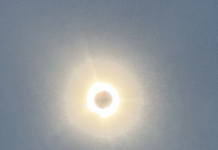So this is what it feels like to be an ice cube and live in a freezer. You know the weather is really bad when local newscasters say things like, “Any exposed flesh will freeze within five minutes of being out in the elements.”
And it’s only January 8. Winter won’t be seeing its way out for another 83 days (at minimum).
We’ve all heard advice on how to “survive” winter. “Embrace it,” the locals say. And I do agree with that. I think it’s important to invest in a warm jacket, some good winter boots, and a pair of fur-lined mittens and try to find an outdoor activity you enjoy (for me, it’s sledding, snowboarding, and snowtubing, for my dad and brothers it’s ice fishing, for my father-in-law it’s snowmobiling). I also think surviving winter, sometimes, involves escaping winter. And when you can’t escape on an airplane to a warm destination or even spend a weekend at an indoor waterpark ignoring the cold, the next best thing is ordering a “summery” drink (my favorite is a margarita on the rocks) or—what I highly recommend—heading over to the Tropical Encounters exhibit at Como Park Zoo & Conservatory in St. Paul.
 As soon as you walk in, you’re hit with a blast of warm, damp air. It is heavenly. Off go the hats and jackets. Instead of seeing dirty snow, you see green plants and trees. For a little while, you can pretend it’s a balmy July afternoon and your friends will be over later for a backyard bbq.
As soon as you walk in, you’re hit with a blast of warm, damp air. It is heavenly. Off go the hats and jackets. Instead of seeing dirty snow, you see green plants and trees. For a little while, you can pretend it’s a balmy July afternoon and your friends will be over later for a backyard bbq.
In addition to the tropical plants and trees, we saw a sloth, an anaconda, a giant tarantula, leaf-cutter ants and scorpions (yuck), frogs, and giant river turtles and freshwater stingrays. Just as many adults were admiring the critters as kids. I actually think there were more adults than kids in this part of the zoo. How often do you get to see an anaconda up close? Or a hairy tarantula? Or a sloth?
We learned that tropical rainforests produce 40 percent of the earth’s oxygen, store massive amounts of carbon, and now cover less than 6 percent of the earth’s land surface. When you live in Minnesota, it’s easy to forget that we’re connected to these remote ecosystems. Without these beautiful places, we’d not only lose this renewable source of clean air, the indigenous people and 50-70 million living species (two-thirds of all living species in the world!) would lose their homes. We’d also lose bananas, chocolate, and sugar as we know it. Visiting the Tropical Encounters exhibit was a good reminder that our rainforests are still disappearing at an alarming rate, and to do our part we should use recycled paper, avoid furniture made from rainforest woods like mahogany, ebony, and rosewood, choose foods without palm oil, and conserve fossil fuels.
In addition to getting a rare glimpse into the rainforest, we also ventured outside (brrr!) to the buildings that house the giraffes (we wanted to see the “baby” giraffe, who was 6 feet tall at birth), the zebras, the little energetic arctic fox running in circles, one giant polar bear taking a nap outside without a care in the world, and the gorillas, orangutans, and monkeys. I actually liked visiting the animals in winter, when the crowds are minimal and your kids don’t have to wait forever to see the animals up close. It was nice to spend more time watching the monkeys, rather than feeling like you have to hurry up and move along to give someone else a chance to watch them from a spot near the glass.
The zoo is open every day from 10 a.m. to 4 p.m. throughout the winter. Admission is free, but a voluntary donation of $3 per adult and $2 per child is appreciated to help care for the plants and animals. Single-seat strollers and wheelchairs are available for rent at $4 per day; scooters can be rented for $20 per day. For more information, visit comozooconservatory.org.







